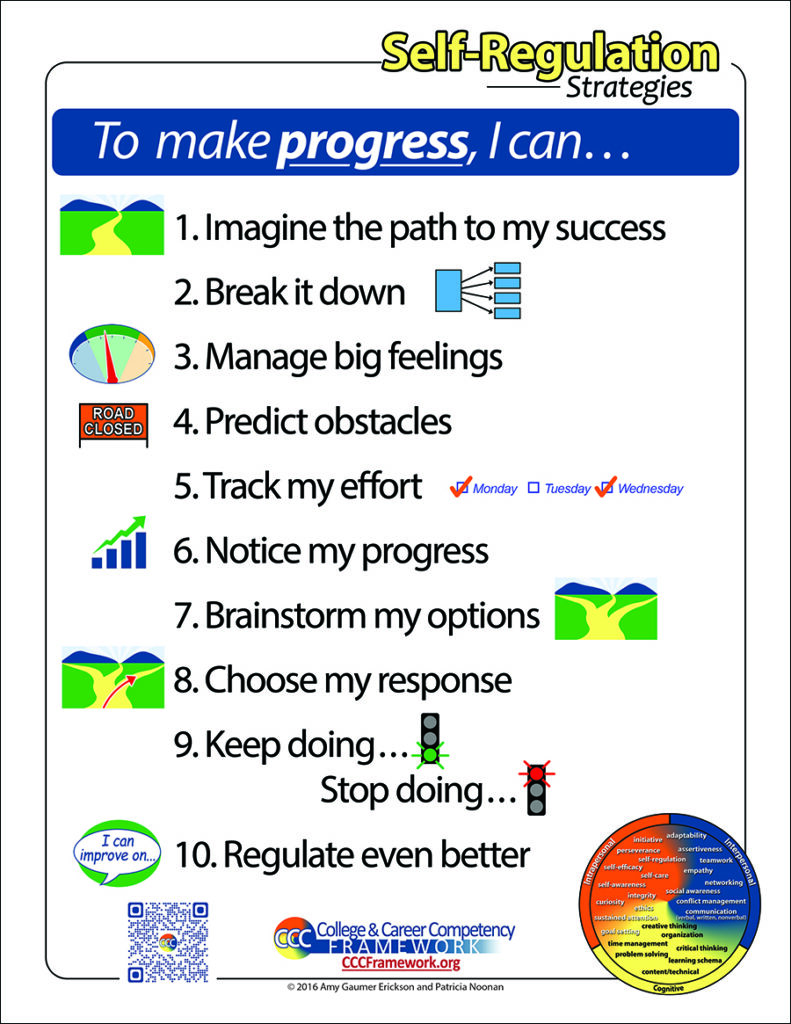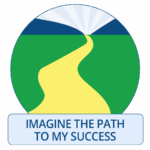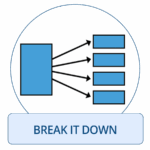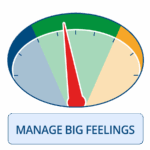Does your child have difficulty staying on task or remembering to complete their chores? Maybe your child struggles with managing their emotions when they become frustrated or stressed. Teaching your child Self-Regulation Strategies can help improve their ability to complete tasks and manage their emotional reactions.
Definition
Self-regulation is a proactive, self-directed process for attaining goals, learning skills, managing emotional reactions, and accomplishing tasks (Noonan and Gaumer Erickson, 2022).
Students use Self-Regulation Strategies to increase their independence and manage emotional reactions.
Student Impacts
Teachers providing self-regulation instruction and classroom practice observe student growth, including:
- Improved ability to set realistic goals, monitor progress, and evaluate results
- Increased sense of control and awareness of their academics
- Improved understanding of the relationship between actions and progress
Research in elementary and secondary education identifies proven student impacts from teaching self-regulation.
- Learning Self-Regulation Strategies increases students’ academic performance, especially if students are taught when, why, and how they should use certain strategies (Theobald, 2021).
- Students who self-regulate earn better grades and higher scores on standardized assessments (Hattie & Zierer, 2018).
- By receiving explicit instruction in self-regulation, students can better regulate their emotions, leading to decreases in negative internalizing and externalizing behaviors (Finlon et al., 2015).
- Students who use self-regulation recognize more ways to sustain their attention, allowing them to resist common distractions and show more resilience when faced with challenges (Mrazek et al., 2018).

Learning self-regulation from an early age and reinforcing it with practice will help your child improve their ability to focus and have stronger relationships with family and friends.
Watch the one-minute video What Is Self-Regulation? with your child to learn more about what self-regulation is and why it is important. Afterward, share examples of times when you used self-regulation to improve your ability to do something or reach a goal. Use the following questions to ask your child to describe situations where they have used self-regulation before:
- What is something you have learned to do that was very challenging?
- What did you do to start learning it?
- When you felt frustrated and wanted to give up, what did you do to keep learning it?
Explain that you are going to help them learn Self-Regulation Strategies so they can understand how to get started when they have something challenging to learn and how to manage their big feelings when they experience frustration or anger.
In this module, you will learn how to support your child in improving their self-regulation through these four Self-Regulation Strategies: imagine the path to my success, break it down, manage big feelings, and predict obstacles. Additional strategies are explained in the intermediate and secondary parent guidance.

Imagine the Path to My Success
Children improve their self-regulation by thinking about what they need to do and obstacles they could experience as they are working toward goals. Such thinking clarifies goals and prepares children for challenges. When children learn to imagine the path to their success, they visualize themselves completing action steps, overcoming obstacles, and benefitting from their continued efforts.
Explain to your child that when they have a task they need to complete or something they want to learn, they can start by thinking about themselves doing it. They can imagine the path to their success by making pictures in their mind and thinking about things they can do to get started. They should also think about what could go wrong and how they might overcome setbacks.
Provide a personal example of something new you learned to do by using self-regulation. Describe your actions, what you did to keep going when you felt frustrated, and how you knew you were making progress. Then ask your child to describe a time when they learned something new and challenging and how they learned to do it:
- What is something new you learned to do?
- How did you learn it? Did you think about what it would be like when you learned to do it?
- Did you break it into smaller steps?
- What did you do when you felt frustrated and wanted to give up?
Watch the two-minute video Imagine the Path to My Success and discuss how you can visualize yourself doing something as a way to help you learn it:
- What do you do when you imagine the path to your success?
- When have you imagined the path to your success?
Ask your child to describe something they want or need to learn. It can be academic or extracurricular based. Tell them they are going to practice the strategy imagine the path to my success by thinking about actions they will need to complete, challenges they could experience, and what it will look and feel like when they learn it. Use the following prompts to help your child practice the strategy. They can respond verbally, in writing, or by drawing a picture.
- Describe some actions you will need to do?
- What are some challenges you could experience?
- How do you imagine yourself overcoming those challenges?
- Describe what it will look and feel like when you learn it.
Emphasize that imagining the path to their success will help them prepare for what they are about to do and plan how they will overcome setbacks. Inform your child that as they are working on something they want to learn, you will refer to the example they just created to help them track their progress and, if needed, adjust the actions they have described.

Break It Down
Another strategy you can use to help your child learn something new or improve their ability to do something is break it down. Children improve their self-regulation by breaking down a goal or task into small action steps. Breaking it down makes the goal more manageable and helps them stay focused on smaller, incremental actions rather than becoming overwhelmed when they look at the task as a whole.
Ask your child:
- Have you ever needed to do something, like finish your chores or learn to ride a bike, but when you thought about it, you felt overwhelmed or afraid because you didn’t know where to start?
Explain to your child that you are going to help them learn how to get started on something they need to learn so that it doesn’t seem so big and scary. Compare breaking down a task to putting together a puzzle: When we put together a puzzle, we start with one piece at a time. After we find a place for each piece, the puzzle is complete. Breaking down a task is like that: Start with one step at a time, finish that, and then complete a few more steps until they have finished the task or learned to do something.
Watch this two-minute video Break It Down with your child to help them understand the strategy. After the video, ask:
- What does it mean to break it down?
- How does breaking down a big task into smaller pieces help you?
Tell your child that you are going to help them practice the strategy break it down by breaking down the big task of getting ready for bed. Ask your child to imagine it is time to get ready for bed. Have them think about all the actions they need to complete in order to have a good night’s sleep. Some example actions are putting on pajamas, brushing their teeth, turning on a night light, and reading a book.
Divide a piece of paper in quarters and ask your child to write or draw each step they need to complete. Emphasize that getting ready for bed can seem overwhelming because there are so many things to do and remember but that breaking it down into smaller steps makes it easier!
To help your child connect the strategy break it down to something they are currently learning at school, ask them:
- What is something that you are learning at school that feels big?
- How can you break it down? What are some smaller actions you could do to get started?
Remind them that as they work at school or home on something that seems big, they can break it down by thinking of smaller action steps. For example, when they have several math problems to complete, they can break down their problems by completing one or two, taking a deep breath, completing a few more, and checking their work. These smaller steps will make the larger task of completing their math problems seem more manageable.

Manage Big Feelings
Children improve their self-regulation by managing big feelings. When they understand that their mind and body are affected by strong emotions, they learn to use techniques to help minimize their emotional reactions and stay focused on what they need to do.
When children learn to manage their big feelings, they also understand that they have a choice in how they react to emotional situations and that their choices will impact the outcome. It’s important for children to understand that big feelings can make their mind and body feel either fast or slow. For example, their mind and body might feel fast when they experience big feelings like anger or frustration. They might feel their cheeks get warm and their heart beat faster.
Their mind and body might feel slow when they experience emotions like boredom. Their body might feel tired, and their mind might feel sluggish and unfocused. Learning techniques to move their mind and body back to the right speed—like taking deep breaths, going for a walk, or drawing their feelings—will help children know what to do when they experience big feelings.
Watch the three-minute video Manage Big Feelings with your child. After the video, ask:
- When has your mind and body felt fast? What do you think caused it to feel fast?
- When has your mind and body felt slow? What do you think caused it to feel slow?
- What do you do when you manage big feelings?
Tell your child that you are going to help them learn to manage their big feelings. Explain that one way to manage big feelings is to think ahead and plan what they will do when they experience big feelings. Ask your child:
- What are times when you usually have big feelings?
You may need to prompt your child to think about specific times of day or situations, like when they lose a soccer game or when their math problems seem really hard. They might have big feelings when it’s the end of the school day or when they are trying to practice their reading at home.
- What are some things you can do to manage big feelings when your mind and body feel fast?
(e.g., take deep breaths, go for a walk, think positive thoughts) - What are some things you can do to manage big feelings when your mind and body feel slow?
(e.g., go for a walk, get a drink of water, do some stretches)
After your child has identified a time when their mind and body usually feel fast and slow and some techniques for managing their feelings, provide them with two pieces of paper. At the top of the one piece, write “fast.” At the top of the other piece, write “slow.” On one side of the “fast” paper, ask your child to draw or write when they usually have big feelings that make their mind and body feel fast. On the other side of the paper, tell your child to write or draw two different techniques they plan to use to move their mind and body back to the right speed. Repeat this same process with the “slow” paper.
Keep the pieces of paper posted in your home and take time each night to talk to your child about how they managed their big feelings that day. If more techniques are needed, brainstorm new ones to help your child move their mind and body back to the right speed.

Predict Obstacles
As children are working toward a goal, it’s important they understand that they could experience obstacles or challenges along the way. Children improve their self-regulation when they predict obstacles. By using this strategy, they plan what they will do when they experience obstacles rather than allowing the obstacles to derail their efforts. When they have thought about how to overcome potential obstacles, children feel more confident and are more likely to continue making progress.
Watch the two-minute video Predict Obstacles with your child. After the video, discuss what it means to predict obstacles and why it is important:
- What does it mean to predict obstacles?
- How does thinking about obstacles help you when you are working on something?
Explain to your child that they can plan what they will do when they experience an obstacle by creating if–then statements. For example, if they had a goal to improve their reading and planned to read their library book aloud to you each night but they left it at school, they might create the following if–then statement:
IF I forget my library book at school, THEN I will read one I have at home.
Practice this concept with your child, using the following scenarios:
You have a goal to learn to ride your bike without training wheels, and you decide to practice each night after school.
- Predict obstacles that could get in the way of learning to ride your bike without training wheels.
(e.g., the bike could get a flat tire; you could have soccer practice after school) - What is an if–then statement for each of these obstacles?
(e.g., IF my bike has a flat tire, THEN I will ask a sibling to help me air it up; IF I have soccer practice, THEN I will practice riding my bike after that)
You want to improve your ability to calm yourself when you become upset while playing with your friends, so you plan to take a walk the next time you feel angry at your friend.
- Predict obstacles that could get in the way of learning to calm yourself when you feel angry.
(e.g., you could forget to take a walk and instead yell at your friend; you could feel angry in a place where you can’t take a walk, like a classroom) - What is an if–then statement for each of these obstacles?
(e.g., IF I forget to practice calming myself and yell at my friend, THEN I will apologize and try to remember to take a walk next time; IF I am in a place where I can’t take a walk, THEN I will take three deep breaths to calm myself)
Ask your child to think about something they want to learn or improve. Then guide your child into developing two action steps that will help them get started. For example, if your child has a goal to clean their room each day, one action step might be to hang up their clothes, and another action step could be to make their bed.
Once your child has developed two actions steps for something they want to do, ask them to predict obstacles by brainstorming some things that could get in the way of their action steps. Then guide your child to create an if–then statement for the obstacles they have predicted. Check your child’s progress in predicting obstacles and creating if–then statements after a few days. Ask:
- What did you do when you experienced an obstacle?
- How did predicting obstacles help you continue making progress toward your goal?
Remind them that when they have something they want or need to do, they should think about obstacles that could get in the way, and plan how to overcome the obstacles. Learning how to overcome obstacles will help them continue to make progress and improve their self-regulation.
Next Steps
- You can support your child in practicing the strategy imagine the path to my success by prompting them to describe what it will look and feel like as they are learning something new. Encourage them to consider obstacles they may experience along the way and how they will overcome the obstacles.
- When your child is asked to complete a task or assignment, support them in breaking it down by helping them develop action steps they can use to get started. Remind them that staying focused on smaller action steps will help them make progress toward completing the task and make the task seem less overwhelming.
- You can support your child in practicing the strategy manage big feelings by reminding them that when they experience strong emotions, their body will provide them with signals. When they notice those signals, that means it’s time to use calming techniques. If your child is experiencing big feelings at school, you can help them at home by supporting them in planning what they will do in those situations. Ask them to describe what their body might feel like and the calming techniques they will use.
- You can support your child in practicing the strategy predict obstacles by reminding them that setbacks and challenges are to be expected when they are learning something new. When they want or need to improve their ability to do something, ask them to brainstorm a couple of obstacles they are likely to experience and create if–then statements for those obstacles. Remind your child that big feelings can also become obstacles so they should consider what they will do when they experience big feelings.
